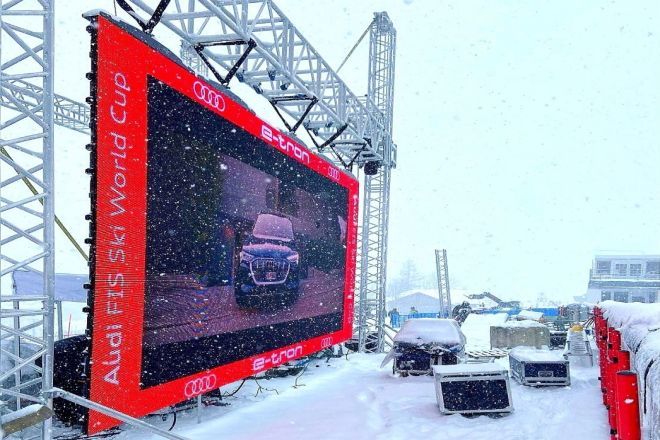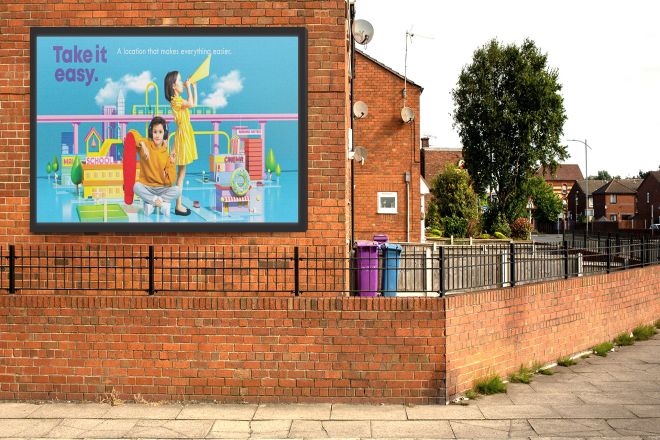Introduction

With the continuous development of science and technology, outdoor LED displays have been widely used in various public places, such as squares, commercial streets, stations, etc., and have become an important tool for information dissemination and advertising.
However, due to its exposure to the natural environment, it will inevitably face challenges from various extreme weather conditions. Extreme weather conditions such as heavy rain, high temperature, lightning, low temperature, ice, and snow may have a serious impact on the normal operation and service life of outdoor LED displays.
Therefore, it is particularly important to formulate a set of scientific and reasonable coping strategies and maintenance skills for outdoor LED displays in extreme weather. This is not only related to the stability and reliability of the display but also to the continuity and security of information release.
1. The impact of extreme weather on outdoor LED displays
The impact of extreme weather on outdoor LED displays is multi-faceted, including physical damage, performance degradation, safety hazards, etc. Therefore, we need to take corresponding countermeasures to ensure the stable operation of the display in extreme weather.
- Heavy rain:
In heavy rain weather, outdoor LED displays face serious challenges. First of all, heavy rain may cause short circuits in the internal circuits of the display or damage to components because moisture may penetrate into the protective layer of the display and directly contact the circuit board or sensitive components.
In addition, accumulated water will not only cause physical damage to the display but may also affect its display and heat dissipation performance. Accumulated water will block the light transmission of the LED lamp beads, causing the display content to be blurred or distorted. At the same time, accumulated water will also hinder the normal operation of the cooling fan or heat sink, causing the display to overheat.
- Hot weather:
The impact of high-temperature weather on outdoor LED displays cannot be ignored. A long-term high-temperature environment will accelerate the aging process of the display components, thus shortening its service life. In addition, high temperatures will increase the amount of heat generated by the display, causing the display temperature to continue to rise.
If the heat dissipation is poor, the display may overheat, which will not only affect the display effect and stability but may also cause hardware damage or fire and other safety hazards.
- Thunder and lightning weather:
Lightning weather poses a great threat to outdoor LED displays. The strong current generated by lightning may directly destroy the display screen or damage related equipment, causing irreversible losses.
Even if lightning does not directly hit the display screen, the lightning electromagnetic pulse may interfere with the display’s control system, causing the display to not work properly or data to be lost.
- Low temperature and ice and snow weather:
In low temperatures and ice and snow weather, outdoor LED displays also face challenges. Low temperature may cause the performance of the internal components of the display to degrade or even freeze and damage. This is because low temperature will solidify the liquid medium inside the component, causing a short circuit or failure of the circuit.
In addition, snow and ice may also cover the surface of the display, affecting its heat dissipation and visual effects. Snow will block the light transmission of LED lamp beads, causing the display content to be blurred or distorted, while ice may increase the weight of the display and make it bear greater pressure.
2. Strategies for dealing with extreme weather

- Preventive measures:
During the design stage, extreme weather factors are fully considered, and materials and components that are waterproof, dustproof, lightning-proof, and resistant to high and low temperatures are selected to ensure that the display screen can operate stably in harsh environments.
Establish a sound maintenance system, conduct regular inspections and maintenance of the display screen, discover and solve potential problems in a timely manner, and maintain the good condition of the display screen.
Set up drainage ditches and waterproof facilities around the display screen to ensure timely drainage during heavy rains and avoid damage to the display screen caused by the accumulation of water.
- Countermeasures:
When encountering heavy rain, turn off the display power in time to avoid moisture penetration that may cause an internal circuit short circuit or component damage.
In hot weather, add heat dissipation equipment, such as fans, heat sinks, etc., to improve the heat dissipation performance of the display and ensure that it operates at a suitable temperature.
During thunder and lightning weather, take lightning protection measures, such as installing lightning rods, lightning arresters, etc., to reduce lightning damage to the display and ensure the safe operation of the display.
In low temperatures and ice and snow weather, strengthen insulation measures, such as using insulation materials to wrap the display screen, to prevent low-temperature damage to internal components and ensure that the display screen operates within a suitable temperature range.
- Emergency treatment:
Establish an emergency response mechanism and formulate detailed emergency plans to ensure rapid response when a display fails.
Once the display fails, professional maintenance personnel should be quickly organized to carry out emergency repairs to restore the normal operation of the display as soon as possible and reduce losses.
For display screens that cannot be repaired, replaced, or adjusted their position in a timely manner to ensure the continuity and reliability of information release.
3. Maintenance tips for display screens in extreme weather
1). Heavy rain weather
Inspection of waterproof facilities: Regularly check the waterproof facilities of the display, including waterproof covers, waterproof pads, etc., to ensure that they are intact and prevent rainwater from penetrating into the interior of the display.
Drainage system maintenance: Make sure the drainage system around the display is unobstructed and clean the gutters and drainage holes promptly so that accumulated water can be quickly removed during heavy rains.
Emergency shutdown: During a heavy rainstorm, if excessive precipitation is expected, in order to prevent the display from being damaged by flooding, you may consider temporarily turning off the power of the display.
2). Hot weather
Cooling system inspection: Regularly check cooling fans, heat sinks, and other cooling equipment to ensure that they are working properly and to maintain the appropriate temperature of the display.
Regular cleaning: Clean the heat dissipation holes and heat sinks of the display screen regularly to prevent the accumulation of dust and debris from affecting the heat dissipation effect and ensure that the display screen can dissipate heat normally in high-temperature environments.
Set the brightness appropriately: In hot weather, in order to reduce the heat generated by the display, you can appropriately reduce the brightness of the display to reduce energy consumption and heat generation.
3). Thunder and lightning weather
Lightning protection equipment inspection: Regularly check the lightning protection equipment of the display screen, such as lightning rods, lightning arresters, etc., to ensure that they are working properly, which can effectively reduce the damage to the display screen caused by lightning.
Power-off protection: In thunder and lightning weather, in order to avoid the direct impact of lightning on the display screen, you can consider temporarily turning off the power supply of the display screen to ensure its safety.
4). Low temperature and ice and snow weather
Insulation measures: Set up insulation facilities around the display screen, such as using insulation materials to wrap the display screen, to reduce the impact of low temperature on the internal components of the display screen and ensure that the display screen can operate normally in low-temperature environments.
Snow and ice removal: Regularly remove snow and ice from the display to ensure that the display surface is clear and does not affect heat dissipation and visual effects.
5). Other maintenance tips
Regular inspection: Regularly inspect the display screen to check whether its operating status and various functions are normal and to discover and solve problems in a timely manner.
Back up data: Regularly back up the control software and configuration files of the display so that it can be restored quickly and reduce losses when problems occur.
Timely maintenance: Once a fault or abnormality is found on the display screen, professionals should be immediately organized to repair and replace it to ensure the stable operation of the display screen.
4. Safety Precautions

- Safety first:
When performing any maintenance work on outdoor LED displays, the first consideration is safety. Staff must strictly abide by relevant safety regulations and operating procedures to ensure their own safety and that of others. This includes, but is not limited to, wearing appropriate protective equipment, following electrical safety regulations, etc.
- Professional operation:
Maintenance and repair work on the display should be performed by professionals with professional knowledge and skills. They understand the working principle, structural characteristics, and operating requirements of the display screen and can ensure the correctness and safety of maintenance work.
If non-professionals attempt repairs, it may cause more problems or safety hazards.
- Records management:
It is very important to record and manage the maintenance status of the display screen. These records should include maintenance time, content, personnel, results, and other information to track and evaluate the operating status and maintenance effects of the display.
Through record management, potential problems can be discovered in time, targeted maintenance plans can be formulated, and the stability and reliability of the display can be improved.
In short, when performing maintenance work on outdoor LED displays, we must always keep in mind the three principles of safety first, professional operation, and record management to ensure that the display can operate stably and extend its service life.
Conclusion
In short, the response and maintenance of outdoor LED displays in extreme weather is a complex and important task. Only by formulating scientific and reasonable strategies and taking comprehensive and effective measures can we ensure the stable operation of the display screen in extreme environments and extend its service life.
This article is helpful to you. If you want to know more about LED displays, please get in touch with us.
